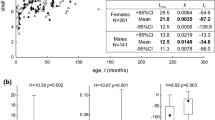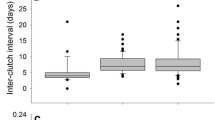Abstract
Variation in offspring size and number has been described for a wide range of organisms. Many theoretical models predict that in a given environment, the production of one single offspring size would yield the highest parental fitness. In most planktonic cladocerans, however, offspring size has been found to increase with size and age of the mother, and as individuals of variable size often co-occur within a population, offspring of variable sizes can be produced simultaneously. In this study, I investigated the relationship between age of the mother and size of her offspring to assess at what age of the mother the optimal offspring size was produced. Optimal offspring size was defined as that size of the offspring yielding the highest parental fitness, which translates to a definition of optimal offspring size as the one having the highest juvenile fitness per unit effort put in these juveniles. I observed that the youngest females produced offspring with the highest juvenile fitness per unit effort, and hence concluded that offspring produced by these females were of optimal size. Larger offspring produced by older females were estimated to yield only 70% of the potential fitness of optimally sized offspring.
Similar content being viewed by others
References
Boersma, M. (1995) The allocation of resources to reproduction in Daphnia galeata: Against the odds? Ecology 76, 1251–1261.
Brockelman, W.Y. (1975) Competition, the fitness of offspring, and optimal clutch size. Am. Nat. 109, 677–699.
Christiansen, F.B. and Fenchel, T.M. (1979) Evolution of marine invertebrate reproductive patterns. Theor. Popul. Biol. 16, 267–282.
Congdon, J.D. and Gibbons, J.W. (1987) Morphological constraint on egg size: A challenge to optimal egg size theory? Proc. Natl. Acad. Sci. USA 84, 4145–4147.
Crump, M.L. (1981) Variation in propagule size as function of environmental uncertainty for tree frogs. Am. Nat. 117, 724–737.
De Meester, L. (1994) Life histories and habitat selection in Daphnia — divergent life histories of D. magna clones differing in phototactic behaviour. Oecologia 97, 333–341.
De Meester, L. (1995) Life history characteristics of Daphnia magna clones differing in phototactic behaviour. Hydrobiologia 307, 167–175.
Dodson, S.I. (1974) Adaptive change in plankton morphology in response to size-selective predation: A new hypothesis of cyclomorphosis. Limnol. Oceanogr. 19, 721–729.
Ebert, D. (1993) The trade-off between offspring size and number in Daphnia magna — the influence of genetic, environmental and maternal effects. Arch. Hydrobiol. (suppl.), 90, 453–473.
Ebert, D. (1994) Fractional resource allocation into few eggs — Daphnia as an example. Ecology 75, 568–571.
Endler, J.A. (1986) Natural Selection in the Wild. Princeton University Press, Princeton, NJ.
Enserink, L., de la Haye, M. and Maas, H. (1993) Reproductive strategy of Daphnia magna — implications for chronic toxicity tests. Aquat. Toxicol. 25, 111–123.
Glazier, D.S. (1992) Effects of food, genotype, and maternal size and age on offspring investment in Daphnia magna. Ecology 73, 910–926.
Gliwicz, Z.M. and Guisande, C. (1992) Family planning in Daphnia — resistance to starvation in offspring born to mothers grown at different food levels. Oecologia 91, 463–467.
Green, J. (1956) Growth, size and reproduction in Daphnia (Crustacea: Cladocera). Proc. Zool. Soc. Lond 126, 173–204.
Guisande, C. and Gliwicz, Z.M. (1992) Egg size and clutch size in 2 Daphnia species grown at different food levels. J. Plankton Res. 14, 997–1007.
Kaplan, R.H. (1980) The implications of ovum size variability for offspring fitness and clutch size within several populations of salamanders (Ambystoma). Evolution 34, 51–64.
Lack, D. (1947) The significance of clutch size. Ibis 89, 309–352.
Lampert, W. (1987) Feeding and nutrition in Daphnia. Mem. Ist. Ital. Idrobiol. 45, 143–192.
Lampert, W. (1991) The dynamics of Daphnia magna in a shallow lake. Verh. Int. Ver. Limnol. 24, 795–798.
Lampert, W. (1993) Phenotypic plasticity of the size at 1st reproduction in Daphnia — the importance of maternal size. Ecology 74, 1455–1466.
Lampert, W., Schmitt, R.D. and Muck, P. (1988) Vertical migration of freshwater zooplankton: Test of some hypotheses predicting a metabolic advantage. Bull. Mar. Sci. 43, 620–640.
Lynch, M. and Ennis, R. (1983) Resource availability, maternal effects, and longevity. Exp. Gerontology 18, 147–165.
McGinley, M.A., Temme, D.H. and Geber, M.A. (1987) Parental investment in offspring in variable environments: Theoretical and empirical considerations. Am. Nat. 130, 370–398.
Mooij, W.M. and Boersma, M. (1996) OSIRIS: An object oriented simulation framework for individual based simulations. Ecol. Model. 93, 139–153.
Parker, G.A. and Begon, M. (1986) Optimal egg size and clutch size: Effects of environment and maternal phenotype. Am. Nat. 128, 573–592.
Philippi, T. and Seger, J. (1989) Hedging one's evolutionary bets, revisited. Trends Ecol. Evol. 4, 41–44.
Robertson, A.L. (1988) Life history of some species of Chydoridae (Cladocera: Crustacea). Freshwater Biol. 20, 75–84.
Roff, D.A. (1992) The Evolution of Life Histories. Chapman and Hall, New York.
Rose, M.R. (1991). Evolutionary Biology of Aging. Oxford University Press, New York.
Sargent, R.C., Taylor, P.D. and Gross, M.R. (1987) Parental care and the evolution of egg size in fishes. Am. Nat. 129, 32–46.
Semlitsch, R.D. (1985) Reproductive strategy of a facultatively paedomorphic salamander Ambystoma talpoideum. Oecologia 65, 305–313.
Smith, C.C. and Fretwell, S.D. (1974) The optimal balance between size and number of offspring. Am. Nat. 108, 499–506.
Spitze, K. (1991) Chaoborus predation and life-history evolution in Daphnia pulex — temporal pattern of population diversity, fitness, and mean life history. Evolution 45, 82–92.
Stearns, S.C. (1992) The Evolution of Life Histories. Oxford University Press, New York.
Tessier, A.J. and Consolatti, N.L. (1989) Variation in offspring size in Daphnia and consequences for individual fitness. Oikos 56, 269–276.
Tessier, A.J. and Consolatti, N.L. (1991) Resource quantity and offspring quality in Daphnia. Ecology 72, 468–478.
Thompson, J.N. (1984) Variation among individual seed masses in Lomatium grayi (Umbelliferae) under controlled conditions: Magnitude and partitioning of variance. Ecology 65, 626–631.
Vanni, M.J. (1986) Fish predation and zooplankton demography: Indirect effects. Ecology 67, 337–354.
van Noordwijk, A.J. and de Jong, G. (1986) Acquisition and allocation of resources: Their influence on variation in life history tactics. Am. Nat. 128, 137–142.
Vijverberg, J. (1989) Culture techniques for studies on the growth, development and reproduction of copepods and cladocerans under laboratory and in situ conditions: A review. Freshwater Biol. 21, 317–373.
Vijverberg, J. and Richter, A.F. (1982) Population dynamics and production of Daphnia hyalina Leydig and Daphnia cucullata Sars in Tjeukemeer. Hydrobiologia 95, 235–259.
Wilbur, H.M. (1977) Propagule size, number, and dispersion pattern in Ambystoma and Asclepias. Am. Nat. 111, 43–68.
Author information
Authors and Affiliations
Rights and permissions
About this article
Cite this article
Boersma, M. Offspring size and parental fitness in Daphnia magna. Evolutionary Ecology 11, 439–450 (1997). https://doi.org/10.1023/A:1018484824003
Issue Date:
DOI: https://doi.org/10.1023/A:1018484824003




